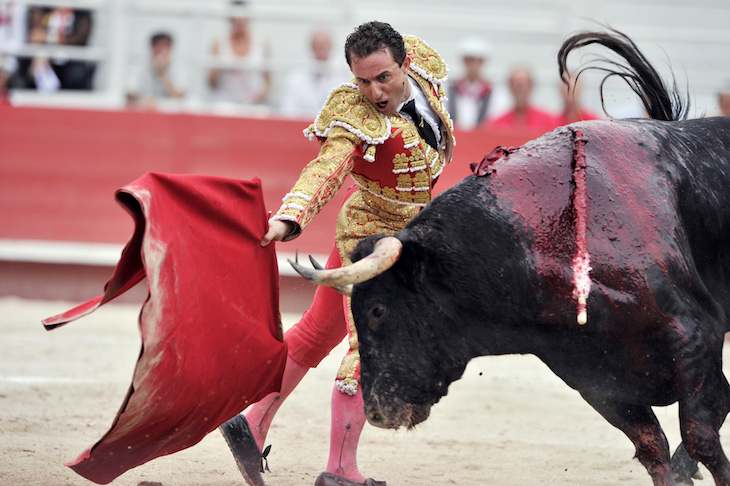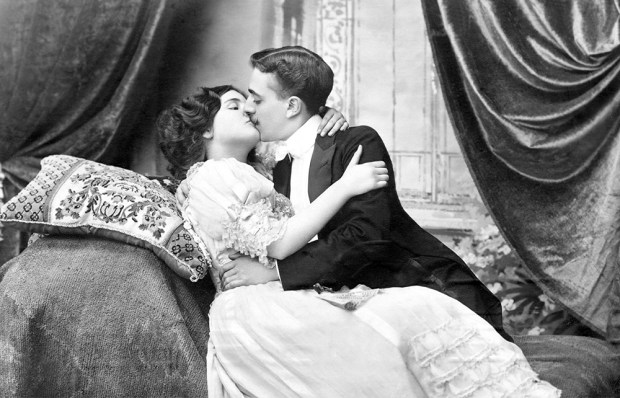Six Partido de Resina (formerly Pablo Romero) bulls for Rafaelillo, Thomas Dufau and Juan Leal. The first corrida of the week-long Nîmes feria. I haven’t seen a bullfight for 15 years; Catriona never. Catriona dislikes cruelty, but was persuaded to try to understand what those who defend the Spanish bullfight actually like about it.
At Nîmes, the bullfights are held in the arena of a Roman amphitheatre. We sat in the cheapest, uppermost tier on a row of cut stone blocks. From there we could see over the rim of the amphitheatre across the city rooftops to the hills beyond. You could smoke up there and we had carried our plastic cups of sweet white wine from the bar below. We each had tied around our necks a cheap, blood-red bull feria neckerchief, bought on a festive impulse from a souvenir stall outside the amphitheatre about five minutes earlier.
The most sensational moment of a bullfight, to my mind, is when the first bull comes galloping out of the gate and into the ring. Unlike your average dairy bull, a well-bred five-year-old Iberian fighting bull is an agile, lithe and beautiful creature. Pablo Romero bulls are exceptionally beautiful. Of all the modern strains of fighting bull, only they and the famous Miura bulls can trace their descent to the foundational Cabrera bloodline. I reasoned that if Catriona could just see a fighting bull with a dash of Cabrera blood come galloping out on to the sand, and never mind the rest of it, she might go away impressed, at least from a zoological point of view.
Majorico, the first bull of the evening, was a stunning ‘negro entrepelado’ (black with grey patches). He was born on 27 February 2014, remained attached to his mother for one year, achieved maturity after three, and now here he was weighing in at just over half an imperial ton and as light on his feet as a circus pony. Majorico has never seen a man on foot before and cannot distinguish the colours green or red.
His executioner this evening was the matador Rafaelillo, born in Murcia, Spain, on 16 July 1979, weighing in at around65 kilos. Majorico was fizzing with aggressive energy. He chased Rafaelillo and his team of cape men all over the ring and butted the wooden boards of their refuges when they narrowly escaped him. The acoustics within the Roman arena were such that even from high up in the gods I could hear the crunch and swish of sand beneath the cape men’s ballet shoes, and Majorico’s hoarse panting.
Then a trumpet blared and into the arena plodded two sinister-looking armoured horses. Astride each sat a fat lance man wearing a wide-brimmed Andalusian hat and toting a hefty wooden lance with a steel tip. I tore my eyes away from my second world war Bausch and Lomb US Navy binocular eyepieces and checked on Catriona. Before this, her knowledge of the Spanish corrida has been largely confined to the lyrics of a song called ‘Little White Bull’ sung by the cheeky cockney comedian Tommy Steele, which Ed ‘Stewpot’ Stewart played regularly on his Junior Choice radio show in the 1970s. She was eyeing these mounted lance men with justifiable disquiet and shrinking a little in her seat.
The lance men took up their positions at each end of the arena. The cape men drew Majorico inexorably towards a horse by seductively flapping their capes at him. Once he had noticed the new, large, stationary target, he charged it, and he persisted in his efforts to knock it down in spite of the spear planted in his back. He charged the horse twice more. Then the horses departed the ring and three separate sprinting men pronged three pairs of barbed sticks into his back and (unfortunately) his sides.
Finally Rafaelillo took the stage with a small cape and pretended to make composite artistic figures of himself, his cape and the tiring bull in slow time. But he was too afraid of Majorico to succeed in this and the crowd became restless and disgruntled. Eventually, he sighted along his extended sword and attempted to kill Majorico with a single thrust, entering through the back of the neck. In this he failed also. The sword was obscenely sticking half in and half out of Majorico, who seemed none the worse for it. There now followed a number of shamefully inept attempts to finish the business with a variety of stabbing weapons. After several minutes of this, Majorico was still on his feet. I lowered my binoculars and looked at Catriona. She had hidden her face behind my back and her body was shaking with sobs. I helped her on her feet and drove her along the row towards the exit. She stumbled forward between the stone blocks of antiquity, broken and blinded with grief. Never before have I seen a festive red neckerchief look so out of place.
Got something to add? Join the discussion and comment below.
Get 10 issues for just $10
Subscribe to The Spectator Australia today for the next 10 magazine issues, plus full online access, for just $10.
You might disagree with half of it, but you’ll enjoy reading all of it. Try your first month for free, then just $2 a week for the remainder of your first year.















Comments
Don't miss out
Join the conversation with other Spectator Australia readers. Subscribe to leave a comment.
SUBSCRIBEAlready a subscriber? Log in